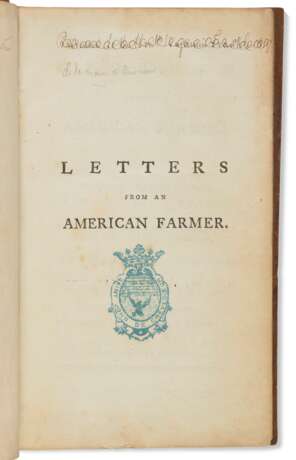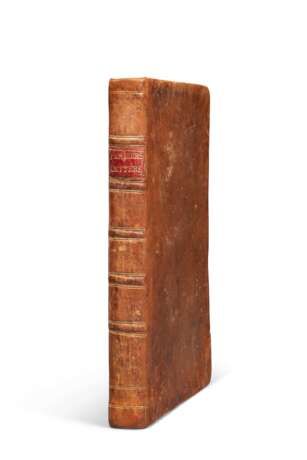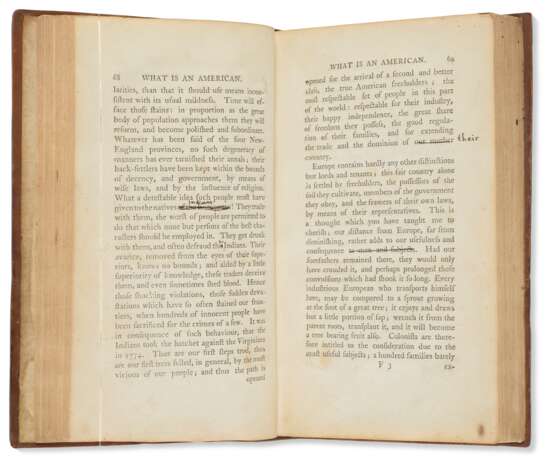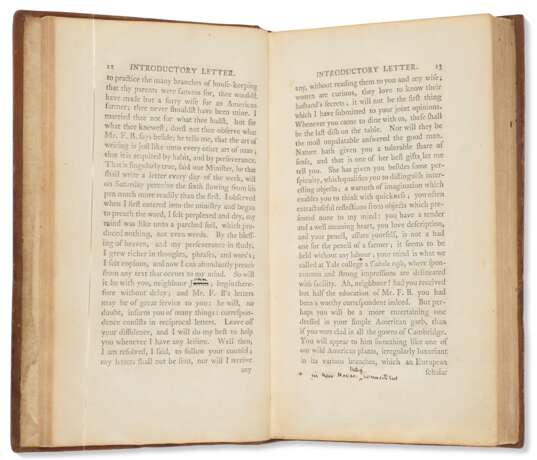ID 517655
Lot 9 | Letters from an American Farmer
Valeur estimée
$ 70 000 – 90 000
The author's own, annotated copy, inscribed for Benjamin Franklin
CRÈVECOEUR, Michel Guillaume ST. JEAN de (1735-1813). Letters from an American Farmer. London: Thomas Davies and Lockyer Davis, 1782.
“What is an American?”
Crèvecoeur's own copy of his seminal work, copiously corrected in manuscript, and once intended for presentation to BENJAMIN FRANKLIN. First edition of the greatest literary description of pre-Revolutionary America, famous for its promulgation of the American “melting” pot and American egalitarianism in Letter III. Less famous, but deserving of reappraisal, for its disgust of slavery in Letter IX. Inscribed by the author on the half-title: “Presented to the Honble Benjamin Franklin, Esq.” (lined through in ink but still legible). Sabin 17496; Streeter sale 711; Vail 674.
Crèvecoeur, born in France to a noble family and educated by Jesuits, joined the French colonial army as a cartographer in 1755. He surveyed much of the St. Lawrence River Valley by canoe, with Native guides. After the French & Indian War, he emigrated to Orange County, New York, started a family and a farmstead, and began writing the Letters. He naturalized and took the name John Hector St. John. When the Revolution began, he was suspected of monarchist sympathies, unjustly imprisoned, and forced to flee to Europe. However, this European publication of the Letters did much to advance the American cause—both in garnering Whig sympathy and in bolstering a new wave of European immigration. Crèvecoeur was awarded a consulship to the newly formed American republic.
The present, first edition of the Letters was published in London in early 1782 and due to its popularity, a second edition was published soon after, as well as translations into Dutch and German. The first French edition of 1784 was an expanded version, more inclusive of Crèvecoeur’s criticisms of America. Tantalizingly, despite Crèvecoeur’s celebrity as an author and his presence in France concurrent with that of Benjamin Franklin, the two men seem never to have met. Crèvecoeur’s family was in Caen and when he did travel to Paris, his failure to rendezvous with Franklin seems to have been an unfortunate mistake. Their great mutual friend Madame d’Houdetot had written to Franklin in the fall of 1781 with a warm recommendation of “Monsieur Crèvecoeur,” the name by which he was known in France. When the author wrote to him some weeks later, he used the name “St. John” by which he was known in America. Madame d’Houdetot wrote again in August of 1782, urging Benjamin Franklin to visit her at Sannois where Crèvecoeur was staying. The author had spent the earlier part of the summer at his father’s estate working on the French version of the Letters, which ended up nearly twice as long as the original English. It was likely during his stay in Sannois that he inscribed this copy for Benjamin Franklin. However, in the summer of 1782, of course, Franklin was extraordinarily busy even by his own standards. Along with John Jay, Henry Laurens, and John Adams, Franklin was drafting the articles of peace with Britain. Peace negotiations were begun in April and the preliminary articles were signed in November, 1782.
There are manuscript annotations on more than 30 pages of the present book and they may also have been written in the summer of 1782. Most significantly this copy shows tinkering with one of most famous phrases in the Letters, in Crèvecoeur's own words, “the motto of all emigrants:” “Ubi panis ibi patria [Where there is bread, there is my country.]”This copy has the insertion, “et libertas:” i.e., WHERE THERE IS BREAD AND LIBERTY, THERE IS MY COUNTRY, (p. 51). Two pages later, the first word of “British America” is crossed out to leave only the word “America” (p. 53) and elsewhere he deleted references to Americans as “subjects” (p. 69) or living in “colonies” (p. 10); the whole tending to update the text to reflect the close of the Revolutionary War and impending peace. Crèvecoeur had sold the manuscript of Letters to his London publishers in May, 1781, when the outcome of the War was very far from certain, even for a patriot. This is an extraordinarily personal copy of a great American classic, and, by its connection to Franklin, intimately associated with a critical few months in American history. See Allen & Asselineau, St, John de Crèvecoeur: The Life of an American Farmer, 1987.
Octavo (205 x 122mm). Half-title. 2-page publisher's advertisement at end. Lacking the two maps; the map guards are present but they appear to have never been bound in (a proof or advance copy?). Contemporary sheep, red morocco lettering piece (neat repairs to corners and joints). Provenance: Michel Guillaume St. Jean de Crèvecoeur (numerous manuscript corrections, inkstamp to half-title and lower flyleaf, autograph presentation inscription on half-title) – early 20th century pencil note that this copy was retained by the author’s family – anonymous owner (Ader, Paris, 26 November 2015, lot 254).
| Adresse de l'enchère |
CHRISTIE'S 20 Rockefeller Plaza 10020 New York Etats-Unis | ||||||||||||||
|---|---|---|---|---|---|---|---|---|---|---|---|---|---|---|---|
| Aperçu |
| ||||||||||||||
| Téléphone | +1 212 636 2000 | ||||||||||||||
| Fax | +1 212 636 4930 | ||||||||||||||
| Conditions d'utilisation | Conditions d'utilisation | ||||||||||||||
| transport |
Service postal Service de messagerie ramassage par vous-même | ||||||||||||||
| Modes de paiement |
Virement bancaire | ||||||||||||||
| Heures d'ouverture | Heures d'ouverture
|






